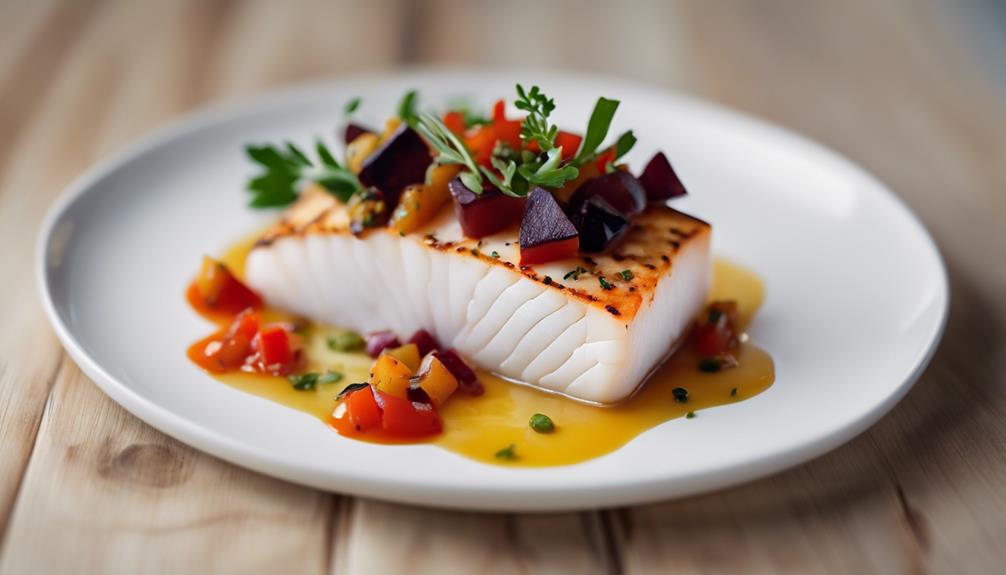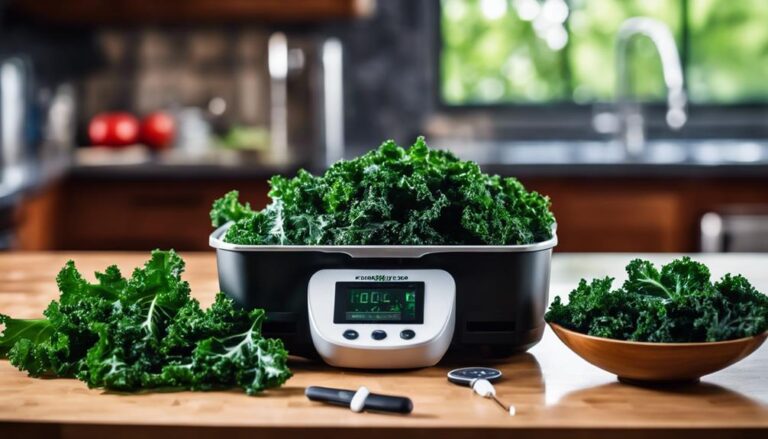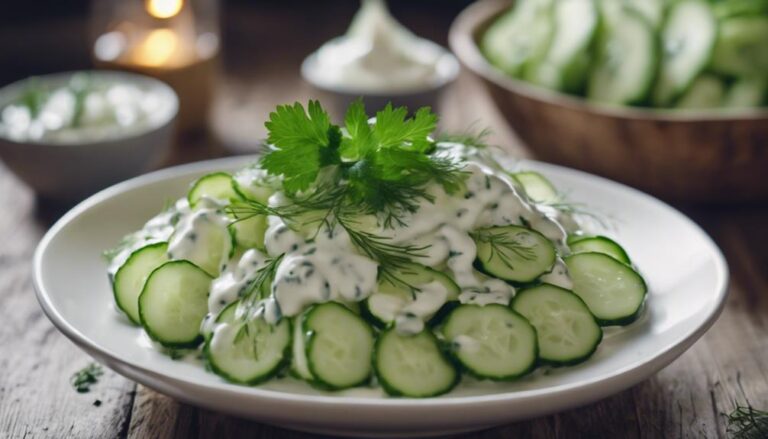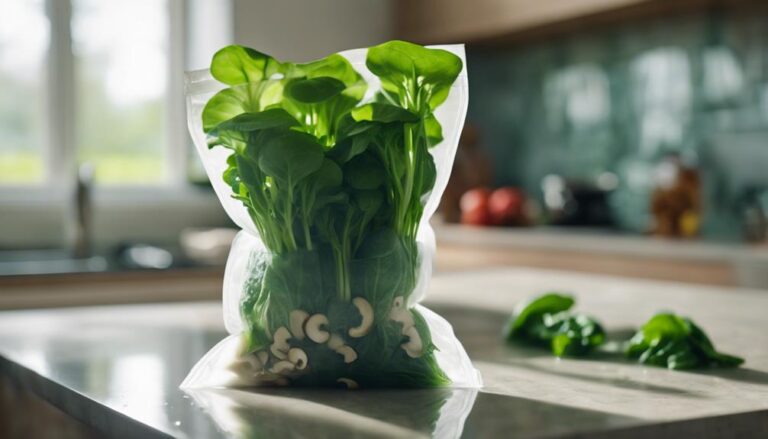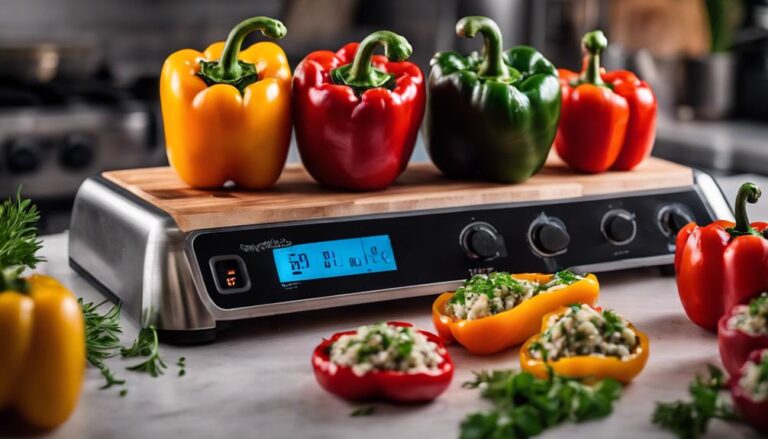Three-Point Sous Vide Halibut With Caponata
You'll start by seasoning your halibut and sealing it in a vacuum bag, ensuring all flavors are locked in. Set your precision cooker to the ideal temperature for that perfectly tender, moist finish—crucial for preserving the delicate texture of the fish. As the halibut cooks, prepare your caponata, simmering eggplant, tomatoes, olives, and capers to create that signature tangy and sweet sauce with briny undertones. This Sicilian antipasto complements the subtle taste of halibut, enhancing each bite. Sear the fish briefly after sous vide for a crispy exterior. This blend of textures and flavors might just become your new signature dish.
What You Will Learn Here
- Sous Vide Halibut with Caponata involves cooking halibut at precise temperatures for optimal tenderness.
- Caponata, a Sicilian dish, complements the halibut with its sweet and sour flavor profile.
- Key ingredients in caponata include eggplant, tomatoes, olives, capers, and vinegar, enhancing the dish's complexity.
- The sous vide technique ensures the halibut retains moisture, flavor, and achieves perfect doneness.
- The dish combines traditional Sicilian flavors with modern cooking methods to create a sophisticated, flavorful meal.
Origins of Caponata Dish
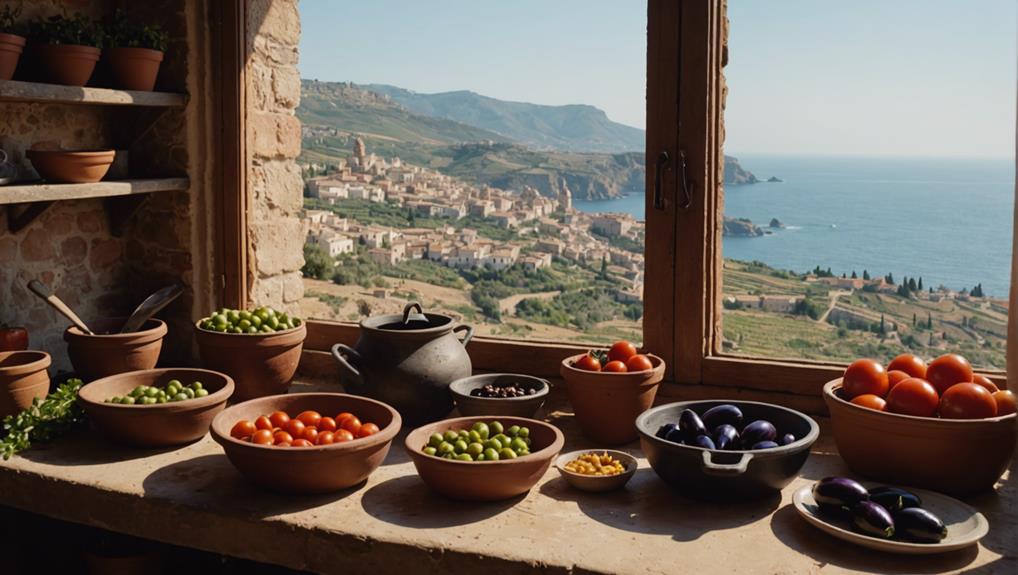
You'll find that the roots of caponata stretch deep into Sicilian cuisine, a tribute to the island's rich culinary history.
This dish showcases a medley of key ingredients like eggplant, celery, and capers, each contributing to its signature robust, tangy profile.
As caponata traveled beyond Italy's shores, it evolved, absorbing local flavors and ingredients, making it a global staple in Mediterranean-inspired cuisine.
Sicilian Cuisine Roots
Caponata, a quintessential Sicilian dish, embodies the island's rich culinary history with its vibrant medley of preserved vegetables and distinctive sweet-sour flavor profile. Originating in the 18th century, this technique-oriented preparation was a practical solution for preserving the bounty of vegetables like eggplant and tomatoes through the winter months.
As a staple of Sicilian cuisine, caponata has evolved into a beloved antipasto, offering a symphony of flavors—tangy vinegar, salty olives, and the deep, savory essence of capers. These ingredients reflect the profound cultural influences, particularly Arabic and Spanish, that have woven their way into the fabric of Sicilian food traditions, making caponata more than just a dish—it's a celebration of Sicily's culinary mosaic.
Caponata Key Ingredients
Exploring the heart of caponata, one must acknowledge that eggplant, tomatoes, olives, and capers constitute the core ingredients, each contributing a unique layer of flavor and tradition to this iconic Sicilian dish.
When you prepare caponata to accompany your sous vide halibut, remember that the eggplant should be cubed and sautéed to a golden tenderness, absorbing the rich, savory notes of the tomatoes and the briny kick from olives and capers.
The addition of vinegar introduces a sweet and sour element, essential for that authentic Sicilian taste. Each ingredient melds harmoniously, creating a caponata that not only complements the delicate flavor of halibut but also stands splendidly alone, serving as a tribute to Sicilian culinary heritage.
Dish's Global Journey
Tracing the origins of caponata, we discover a dish steeped in Sicilian tradition, where local fishermen initially paired the vibrant medley of sautéed eggplant, tomatoes, olives, and capers with the day's catch. This rustic ensemble, enriched by the sharp sweetness of vinegar, found its way from humble seaside meals to the aristocratic tables, evolving with each interpretation.
When you prepare sous vide halibut, consider caponata not just as a side but as a bridge to Sicilian heritage. Each bite, infused with the complexity of flavors—bitter, sweet, salty, and tangy—transports the diner to the heart of Sicily. It's a culinary journey, uniting the delicate textures of halibut with the robust, hearty essence of caponata.
Key Caponata Components
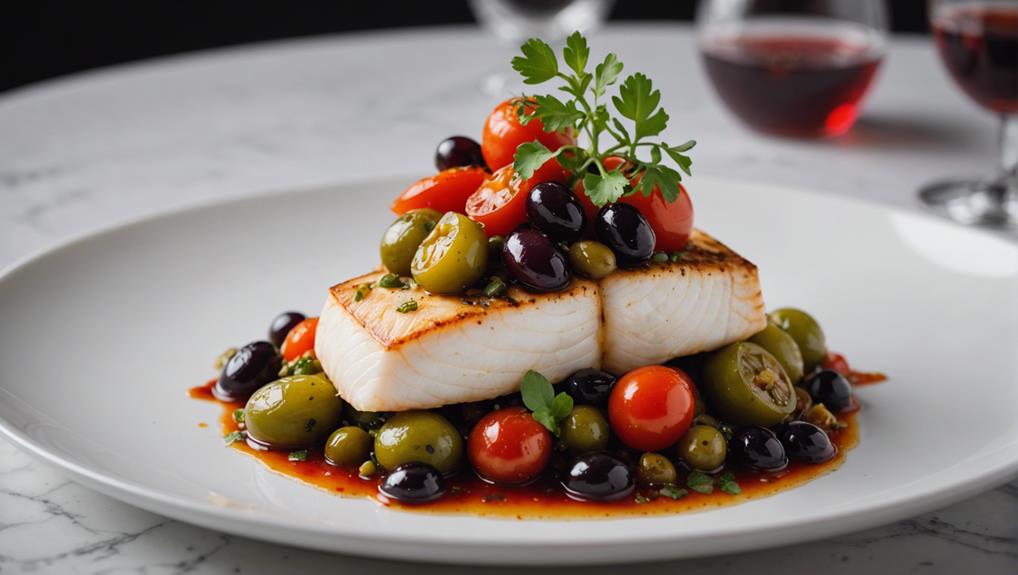
Immerse yourself in the vibrant world of caponata where eggplant, tomatoes, olives, and capers blend harmoniously to create a rich, savory and subtly sweet foundation perfect for enhancing the delicate flavors of halibut. This Sicilian marvel isn't just about tossing ingredients together; it's an art that marries the robust flavors of the Mediterranean in a way that delights the palate.
Caponata is a showcase of balance and depth, where each component plays a vital role in building the profile of the dish. Here's what you'll need to create a caponata that'll impress:
- Eggplant: The spongy texture absorbs flavors while providing a meaty base.
- Tomatoes: They break down to form a tangy, sweet sauce that envelops other ingredients.
- Olives and Capers: These bring briny, salty notes that contrast beautifully with the sweetness of the raisins and the acidity from the vinegar.
- Artichokes: A less traditional but wonderful addition, lending a tender texture and mild taste that complements the robust ingredients.
Don't overlook the importance of a good simmer. Letting your caponata gently bubble allows the vinegar to mellow and the raisins to plump up, infusing the dish with a complex sweetness that pairs splendidly with your sous vide halibut. This technique not only enhances the flavors but also guarantees that every bite is infused with the essence of each ingredient. Remember, your goal is to serve a dish that not only feeds but also enchants.
Top Caponata-Inspired Dishes
You'll adore exploring these top caponata-inspired dishes that showcase the versatility and vibrant flavors of this Sicilian classic.
Try the Sous Vide Halibut Caponata, where the gentle cooking method enhances the halibut's texture, perfectly complementing the robust tanginess of the caponata.
Or, opt for the Baked Caponata Snapper Delight, which pairs the sweetness of snapper with a crispy, caramelized caponata crust.
Stir up a Caponata-Inspired Vegan Tofu Stir-Fry, infusing firm tofu with a bold, savory-sweet caponata glaze.
Sous Vide Halibut Caponata Recipe
While the sous vide technique guarantees your halibut remains tender and moist, topping it with a robust, tangy caponata introduces a delightful contrast that elevates this dish from simple to spectacular. You'll cook the halibut sous vide at 122°F, ensuring it's perfectly tender. Then, top it with a homemade caponata that bursts with the flavors of Sicily.
- Sous Vide Halibut: Cooked precisely at 122°F to retain moisture and guarantee a buttery texture.
- Caponata Topping: A rich blend of eggplant, tomatoes, olives, and capers, simmered in a sweet and sour sauce.
- Buttery Vacuum-Seal: Enhances the halibut's flavor while it cooks evenly in its own juices.
- Flavor Contrast: The caponata's tanginess complements the mild, flaky halibut beautifully.
This recipe brings everyone at your table a taste of refined, mouth-watering sophistication.
Baked Caponata Snapper Delight
Building on the concept of combining seafood with caponata, Baked Caponata Snapper Delight offers a similar fusion of flavors, featuring a well-baked snapper enveloped in the traditional tangy and savory caponata sauce. You'll find the delicate snapper perfectly complements the bold, vibrant flavors of the caponata, made with eggplant, tomatoes, olives, and a dash of vinegar.
- Place the snapper in a baking dish and season generously with salt.
- Add a rich drizzle of olive oil over the fish to enhance its moisture and flavor.
- Grill artichoke hearts lightly to include as a garnish, adding a smoky layer to the dish.
- Combine with halibut for a varied seafood experience, highlighting different textures and flavors.
Caponata-Inspired Vegan Tofu Stir-Fry
Explore the Caponata-Inspired Vegan Tofu Stir-Fry, where firm tofu meets a medley of vibrant vegetables like eggplant and olives, all sautéed in a tangy, caper-infused sauce. This dish not only captures the essence of traditional Italian caponata but transforms it into a delightful plant-based feast.
- Protein-Rich Tofu: Absorbs the flavors while providing a satisfying, chewy texture.
- Robust Vegetables: Eggplant and olives offer a complex, hearty bite.
- Vinegar and Capers: These elements bring the signature zesty caponata tang.
- Vegan and Nutritious: Perfect for anyone seeking a healthy, meat-free meal.
You'll find that this stir-fry isn't just food; it's a flavorful journey through Italy, tailored for a plant-based palate.
Sous Vide Technique Explained
You'll find that mastering the sous vide technique starts with understanding its core concepts and gathering the essential equipment.
By controlling the cooking temperature precisely, you guarantee your halibut is tender, moist, and infused deeply with the flavors of your seasoning.
This method not only elevates the texture and taste but also offers repeatable perfection, making every meal a standout success.
Understanding Sous Vide
Sous vide, a French term meaning 'under vacuum,' is a culinary technique where food is vacuum-sealed in airtight bags and cooked in a precisely controlled water bath. This method allows you to achieve high-quality results, especially when preparing delicate proteins like halibut. The precise control over temperature guarantees even cooking, moisture retention, and a tender texture that can be difficult to achieve through traditional cooking methods. It's a game changer for those who value serving others with excellent dishes.
| Benefit | Description |
|---|---|
| Consistent Results | Even cooking without overcooking edges. |
| Flavor Preservation | Seasonings and juices remain with the food. |
| Moisture Retention | Keeps delicate proteins juicy. |
| Tender Texture | Perfectly soft without being mushy. |
| Quality Replication | Achieve professional standards at home. |
Essential Equipment Needed
To master sous vide cooking, you'll need a few key pieces of equipment: a precision cooker, a vacuum sealer, and a suitable water bath container. The precision cooker is your best friend for maintaining exact temperatures, essential for cooking delicate proteins such as tender halibut. With this tool, you guarantee even, consistent results, making every dish a masterpiece of flavor and texture.
Next, a vacuum sealer is essential. It tightly seals your halibut in a bag, locking in flavors and ensuring ideal heat distribution.
Benefits of Sous Vide
Having covered the necessary equipment for sous vide cooking, let's explore how this technique enhances your culinary creations by maintaining the natural flavors and nutrients of foods like halibut.
By vacuum-sealing your halibut, sous vide cooking locks in flavors and nutrients that are often lost through traditional methods. The precise control you have over temperature guarantees that your fish cooks evenly at a consistent low temperature, achieving perfect doneness without the risk of drying out or overcooking.
This meticulous approach not only preserves the delicate texture of halibut but also amplifies its natural taste. You'll find that sous vide allows you to serve dishes that consistently meet high standards, delighting guests with flavors that are as intended, every single time.
Final Thoughts
Mastering the sous vide technique guarantees your halibut emerges impeccably tender, complemented by a perfectly cooked caponata that accentuates the fish's delicate flavor. By cooking the halibut at a precise 122°F, you make sure that the connective tissues break down just right, allowing the fish to flake beautifully at the touch of a fork. This method not only preserves the moisture but also intensifies the halibut's subtle taste.
When preparing your sides, timing is everything. Introduce vegetables like artichoke hearts into your sous vide bag early enough so they become tender yet retain some bite, enhancing the overall texture of your dish. Drizzle with high-quality olive oil and season generously to elevate the natural flavors of your ingredients. This careful attention to each component builds a harmonious plate that's both visually appealing and gastronomically satisfying.
To finish, a quick sear in a hot pan adds an essential dimension. This step introduces a golden, crispy layer to the otherwise soft halibut, offering a contrast that's both pleasing to the eye and the palate. Whether you choose to finish with grilling or broiling, especially when topped with breadcrumbs, you add an irresistible crunch that makes every bite more dynamic.
Frequently Asked Questions
How Long Does It Take to Sous Vide Halibut?
To sous vide halibut, it takes 30-45 minutes for one-inch filets or up to an hour for thicker cuts. This method enhances flavor, guarantees perfect texture, and maintains every serving consistently delicious.
How Does Bobby Flay Cook Halibut?
Bobby Flay grills halibut, seasoning it with olive oil, salt, and pepper. He prefers grilling over skillets, enhancing flavors with a caponata sauce and fresh parsley, mastering plating and offering culinary tips for serving.
How Long and at What Temperature Should I Cook Halibut?
You should cook your halibut sous vide at 122°F for 30 minutes. For enhanced flavor, explore various seasoning options and marinade recipes. Properly vacuum seal, consider pre-searing, and allow a post-cooking rest before serving.
How to Cook Halibut Like Gordon Ramsay?
To cook halibut like Gordon Ramsay, season generously with salt and pepper, sear for a golden crust, and finish with butter and herbs. Incorporate his philosophy of fresh ingredients for the best flavor and presentation.
Conclusion
You've mastered the gentle art of sous vide, ensuring your halibut emerges succulently tender, infused with subtle flavors. Pairing it with the robust, sweet and tangy caponata not only adds depth but also a delightful contrast.
This dish exemplifies a beautiful meld of technique and tradition, where slow-cooked precision meets rustic, vibrant components. Immerse yourself in each bite, relishing the harmony between the silky fish and the vivacious caponata.
It's a culinary ballet on your palate, every element perfectly choreographed.
